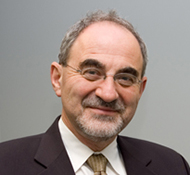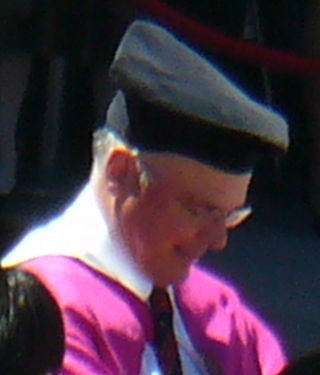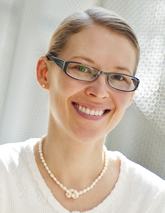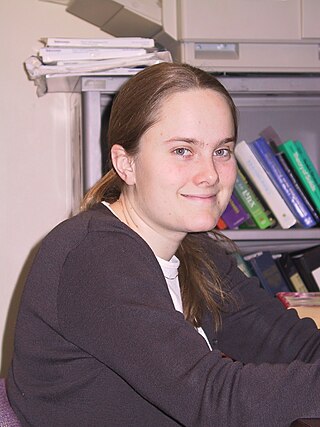Related Research Articles
Optica is a professional society of individuals and companies with an interest in optics and photonics. It publishes journals, organizes conferences and exhibitions, and carries out charitable activities.

Eli Yablonovitch is an American physicist and engineer who, along with Sajeev John, founded the field of photonic crystals in 1987. He and his team were the first to create a 3-dimensional structure that exhibited a full photonic bandgap, which has been named Yablonovite. In addition to pioneering photonic crystals, he was the first to recognize that a strained quantum-well laser has a significantly reduced threshold current compared to its unstrained counterpart. This is now employed in the majority of semiconductor lasers fabricated throughout the world. His seminal paper reporting inhibited spontaneous emission in photonic crystals is among the most highly cited papers in physics and engineering.

Vladimir (Vlad) M. Shalaev is a Distinguished Professor of Electrical and Computer Engineering and Scientific Director for Nanophotonics at Birck Nanotechnology Center, Purdue University.
Denis R Hall FRSE FIEEE FIEE FInstP is a professor of photonics at Heriot-Watt University, Edinburgh. In 2004 he was awarded the Association of Laser Users award for his contributions to the development of industrial lasers and their applications.

Michael Hochberg is an American physicist. He’s authored over 100 peer-reviewed journal articles, has founded several companies, and has been an inventor on over 60 patents. Hochberg's research interests include silicon photonics and large-scale photonic integration. He has worked in a number of application areas, including data communications, biosensing, quantum optics, mid-infrared photonics, optical computing, and machine learning. Much of his work in silicon photonics has been the product of a longstanding series of collaborations with Thomas Baehr-Jones.

Robert Louis Byer is a physicist. He was president of the Optical Society of America in 1994 and of the American Physical Society in 2012.
Rod C. Alferness was president of The Optical Society in 2008.

Anthony Michael Johnson is an American experimental physicist, a professor of physics, and a professor of computer science and electrical engineering at the University of Maryland, Baltimore County (UMBC). He is the director of the Center for Advanced Studies in Photonics Research (CASPR), also situated on campus at UMBC. Since his election to the 2002 term as president of the Optical Society, formerly the Optical Society of America, Johnson has the distinction of being the first and only African-American president to date. Johnson's research interests include the ultrafast photophysics and nonlinear optical properties of bulk, nanostructured, and quantum well semiconductor structures, ultrashort pulse propagation in fibers and high-speed lightwave systems. His research has helped to better understand processes that occur in ultrafast time frames of 1 quadrillionth of a second. Ultrashort pulses of light have been used to address technical and logistical challenges in medicine, telecommunications, homeland security, and have many other applications that enhance contemporary life.
Ali Hajimiri is an academic, entrepreneur, and inventor in various fields of engineering, including electrical engineering and biomedical engineering. He is the Bren Professor of Electrical Engineering and Medical Engineering at the California Institute of Technology (Caltech).
Christopher Dainty is a professor who researches optical imaging, scattering and propagation. In these areas he has published books: Scattering in Volumes and Surfaces, Laser Speckle and Related Phenomena and Image Science (1974) which he co-authored with Rodney Shaw. He has co-authored around 170 peer-reviewed papers and some 300 conference presentations.

Paul F. McManamon is an American scientist who is best known for his work in optics and photonics, as well as sensors, countermeasures, and directed energy.

Shin-Tson Wu, is an American physicist and inventor of Taiwanese origin. He is currently a Pegasus professor at CREOL, The College of Optics and Photonics, University of Central Florida. Wu's contributions to liquid-crystal research and the resulting patent portfolio for next-generation liquid crystal displays (LCDs), adaptive optics, laser-beam steering, biophotonics, and new photonic materials, have had a major impact on display technology worldwide.

Lightwave Electronics Corporation was a developer and manufacturer of diode-pumped solid-state lasers, and was a significant contributor to the creation and maturation of this technology. Lightwave Electronics was a technology-focused company, with diverse markets, including science and micromachining. Inventors employed by Lightwave Electronics received 51 US patents, and Lightwave Electronics products were referenced by non-affiliated inventors in 91 US patents.

David A. B. Miller is the W. M. Keck Foundation Professor of Electrical Engineering at Stanford University, where he is also a professor of Applied Physics by courtesy. His research interests include the use of optics in switching, interconnection, communications, computing, and sensing systems, physics and applications of quantum well optics and optoelectronics, and fundamental features and limits for optics and nanophotonics in communications and information processing.
John Michael Dallesasse is a Professor of Electrical and Computer Engineering at the University of Illinois at Urbana–Champaign where his research is focused on silicon photonic integrated circuits (PICs), nanophotonics, semiconductor lasers / transistor lasers and photonics-electronics integration. He has over 60 publications and presentations, and holds 29 issued patents.
Govind P. Agrawal is an Indian American physicist and a fellow of Optica, Life Fellow of the IEEE, and Distinguished Fellow of the Optical Society of India. He is the recipient of James C. Wyant Professorship of Optics at the Institute of Optics and a professor of physics at the University of Rochester. He is also a Distinguished scientist at the Laboratory for Laser Energetics (LLE) in the University of Rochester. Agrawal has authored and co-authored several highly cited books in the fields of non-linear fiber optics, optical communications, and semiconductor lasers.

Alexandra Boltasseva is Ron And Dotty Garvin Tonjes Distinguished Professor of electrical and computer engineering at Purdue University, and editor-in-chief for The Optical Society's Optical Materials Express journal. Her research focuses on plasmonic metamaterials, manmade composites of metals that use surface plasmons to achieve optical properties not seen in nature.

Michelle Povinelli is a Professor of Electrical Engineering and Physics and Astronomy at the University of Southern California (USC) and Fellow of the OSA and SPIE. Povinelli's research in nanophotonics focuses on the behavior of light inside complex materials.

John E. Bowers is an American physicist, engineer, researcher and educator. He holds the Fred Kavli Chair in Nanotechnology, the director of the Institute for Energy Efficiency and a distinguished professor in the Departments of Electrical and Computer Engineering and Materials at University of California, Santa Barbara. He was the deputy director of American Institute of Manufacturing of Integrated Photonics from 2015 to 2022.

Igor Meglinski is a British, New Zealand and Finnish scientist serving as a principal investigator at the College of Engineering & Physical Sciences at Aston University, where he is a Professor in Quantum Biophotonics and Biomedical Engineering. He is a Faculty member in the School of Engineering and Technology at the Department of Mechanical, Biomedical & Design Engineering, and is also associated with the Aston Institute of Photonic Technologies (AIPT) and Aston Research Centre for Health in Ageing (ARCHA).
References
- ↑ "The Laser Turns 50: A Birthday Bash". Technology. NPR.
- ↑ "Thomas M. Baer : Executive Director". About. Stanford Photonics Research Center. Archived from the original on 2012-10-28.
- 1 2 3 4 "Dr. Thomas M. Baer". Keynote Speakers. IONS (International OSA Network of Students).
- ↑ "How Can NIST Better Serve the Needs of the Biomedical Research Community in the 21st Century?". House Hearing, 111 Congress. U.S. Government Printing Office.
- ↑ Folz, Christina. "ONE Event, Three Perspectives on Optics Startups". Bright Futures. OPN.
- ↑ Park, Alice (9 December 2010). "Predicting IVF Success". Top 10 Medical Breakthroughs of 2010. Time. Archived from the original on December 13, 2010.
- 1 2 Gewin, Virginia. "Industrial Physicist Returns to Academic Roots". Thomas Baer, executive director, Stanford Photonics Research Center, California. Nature.
- ↑ "RSE Welcomes 60 New Fellows" (Press release). Royal Society of Edinburgh. 15 February 2017. Retrieved 28 March 2017.
- ↑ "Summer Graduations 2012". Heriot-Watt University. Retrieved 2016-03-29.
- ↑ Baer, Thomas M. "Thomas M. Baer". BioOptics World.